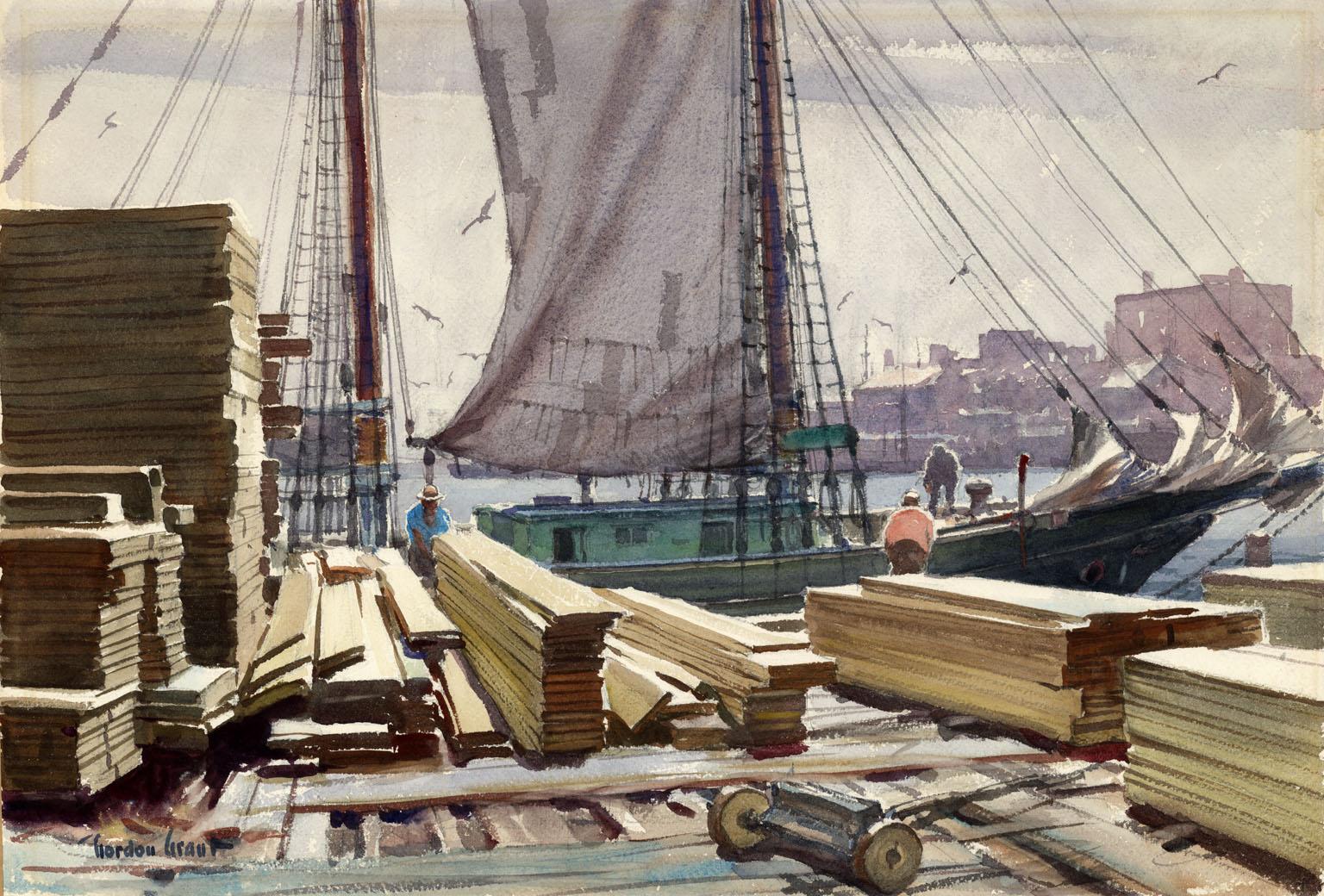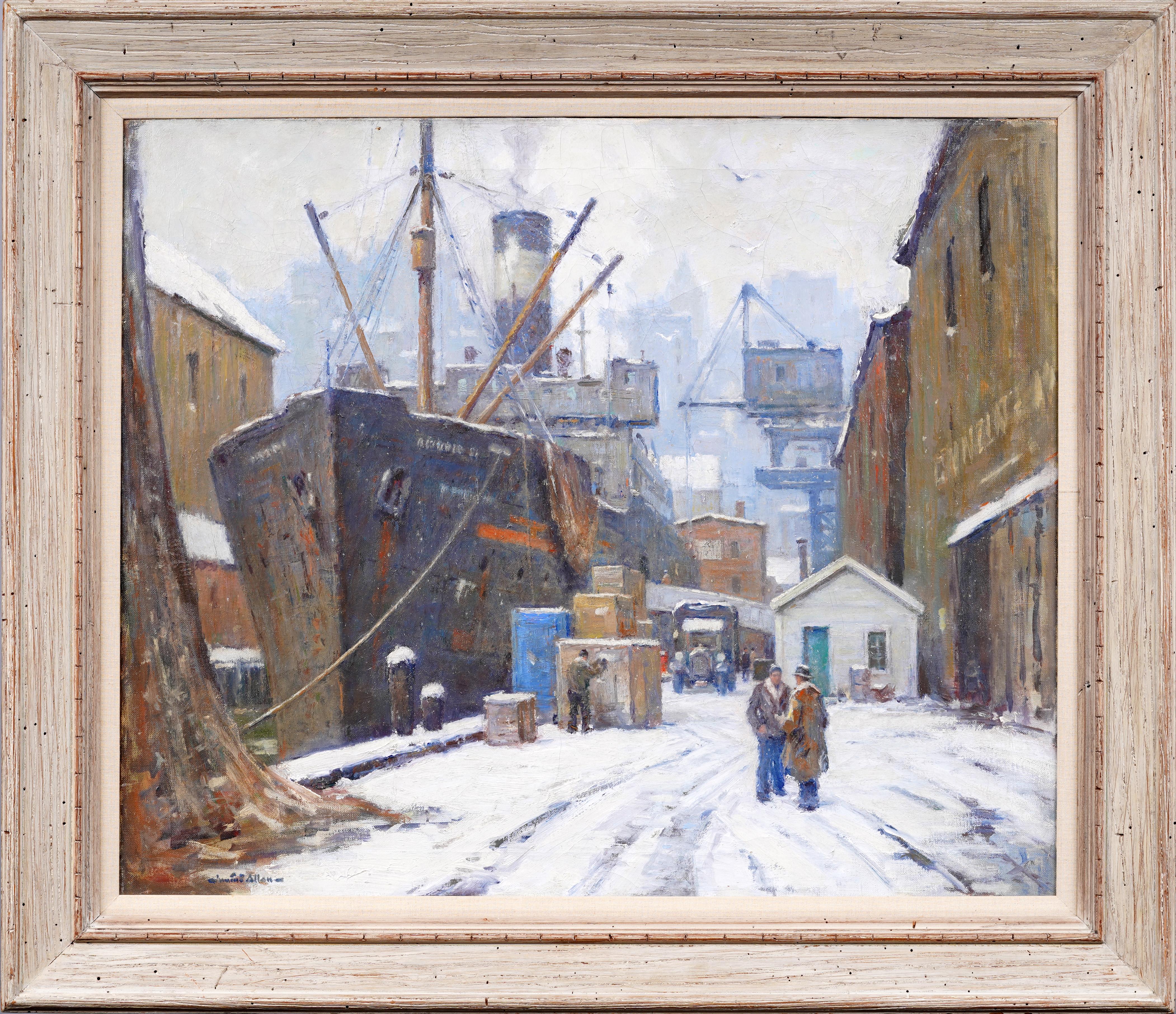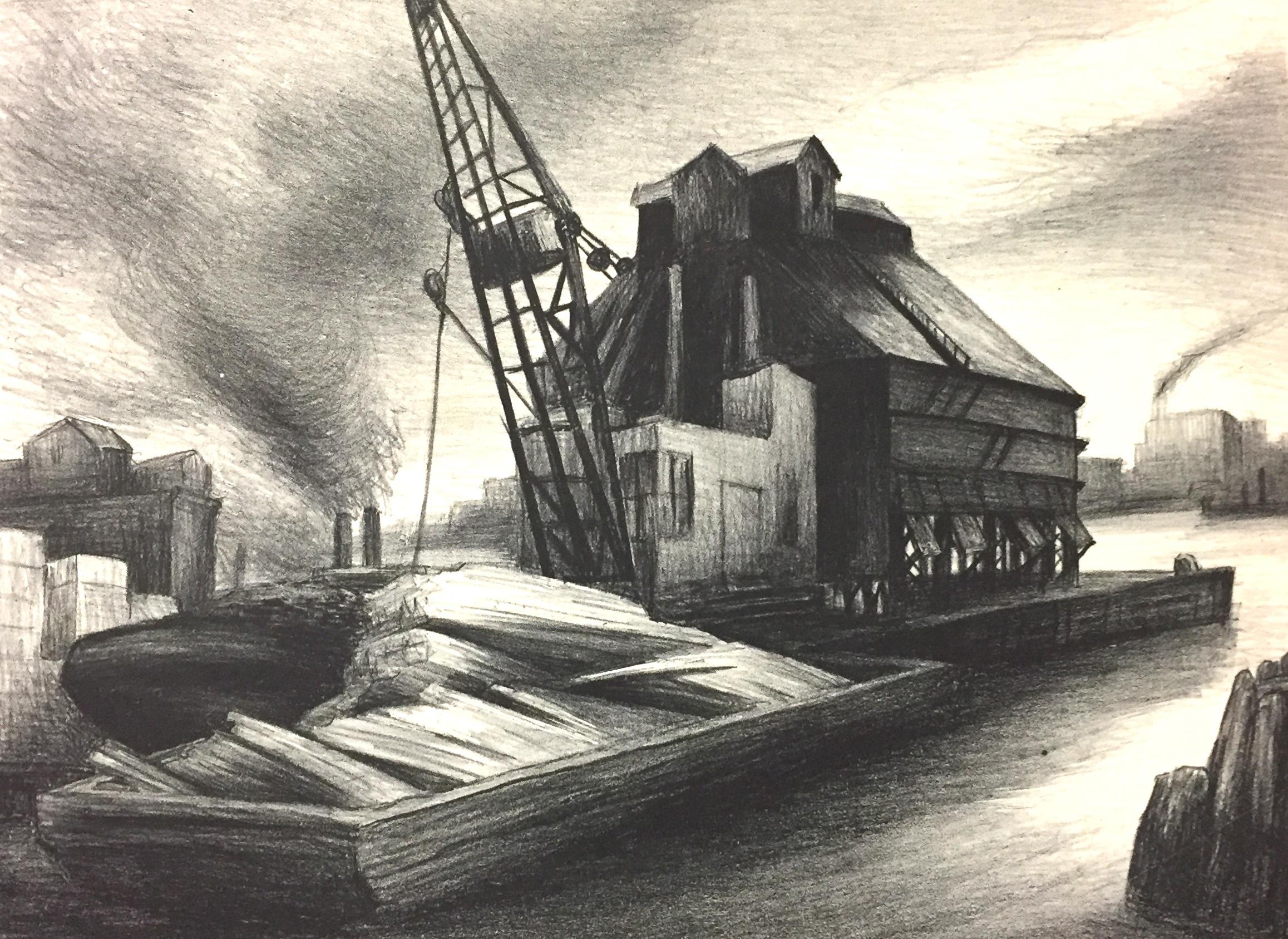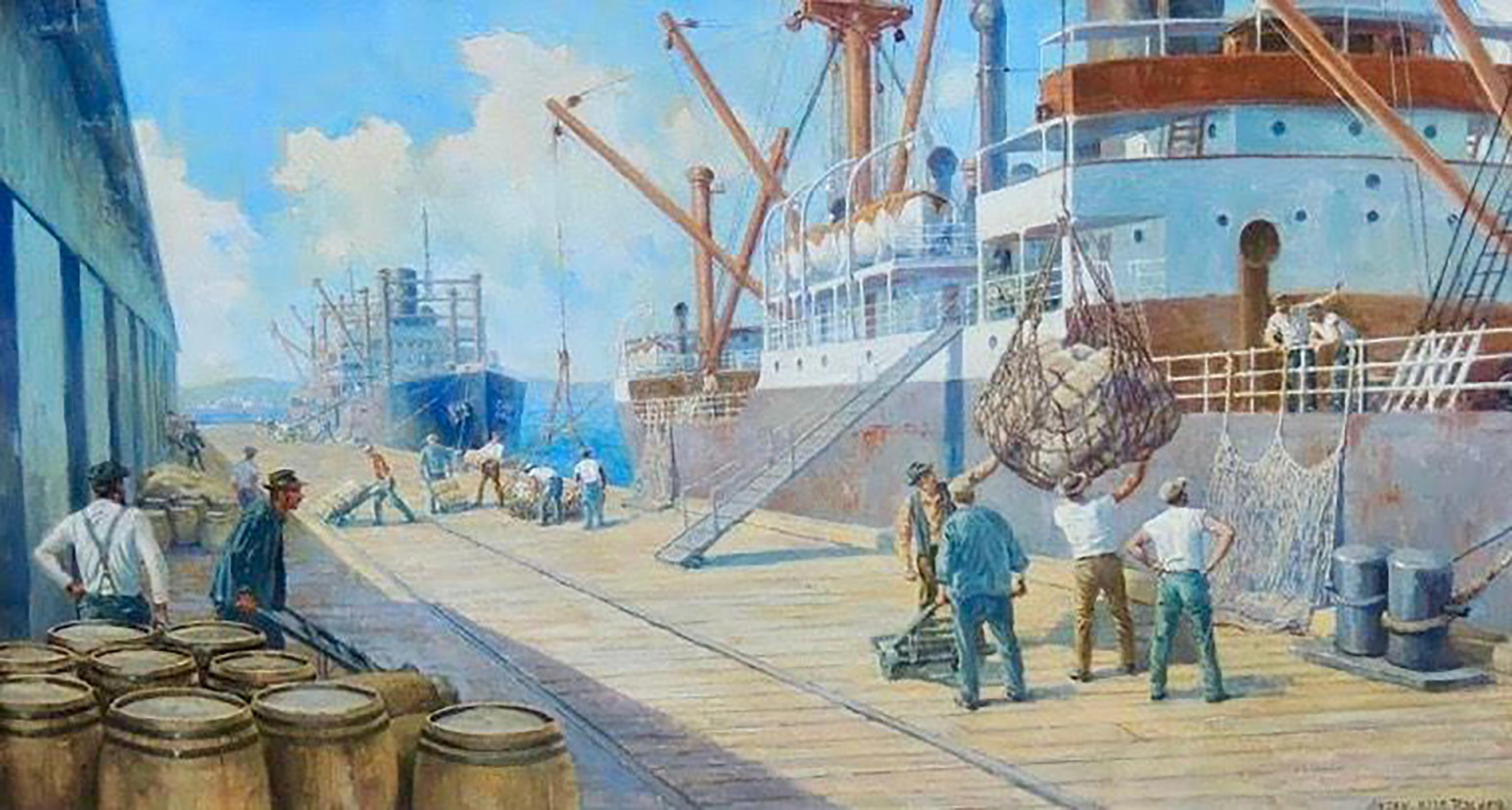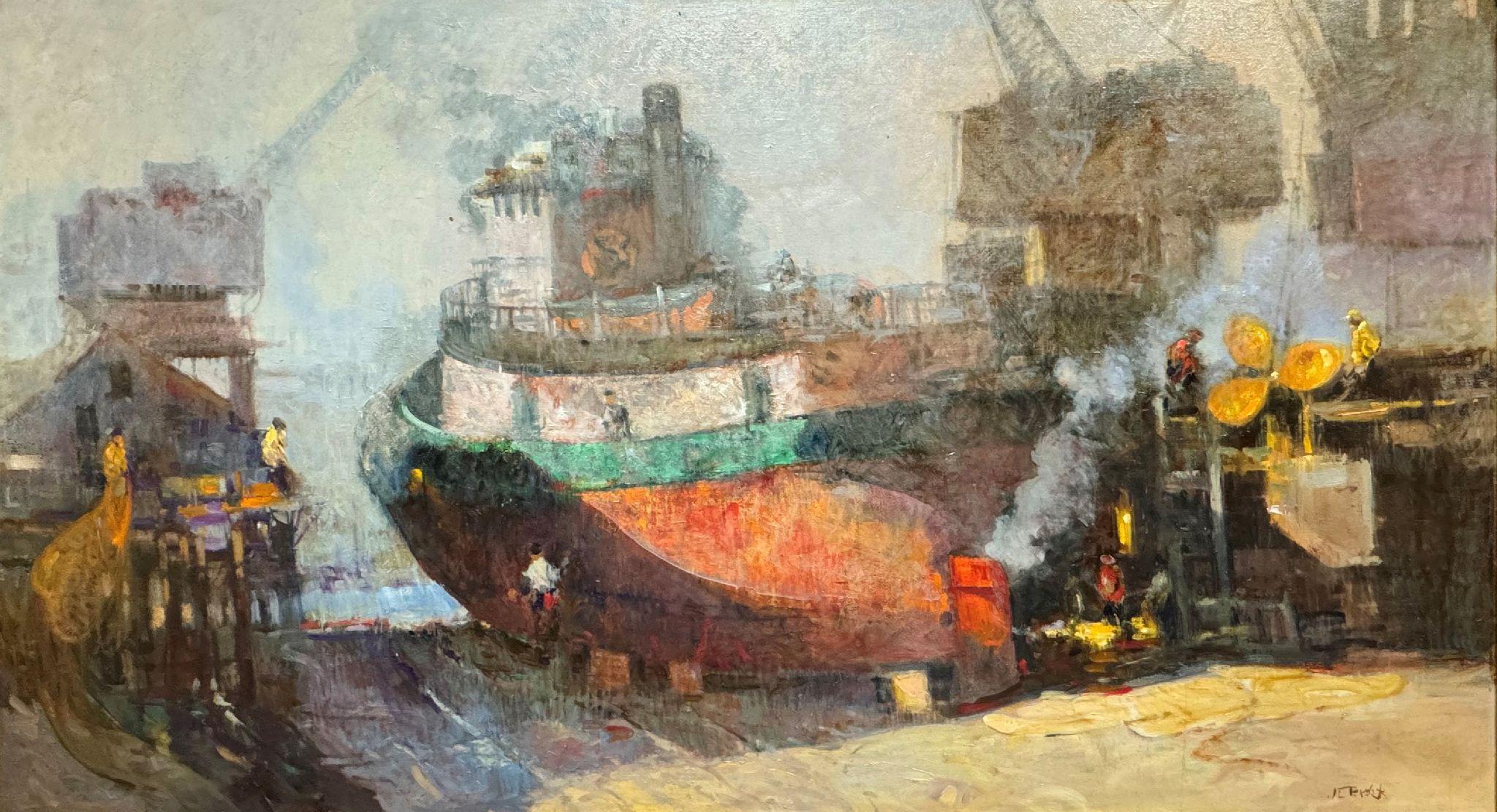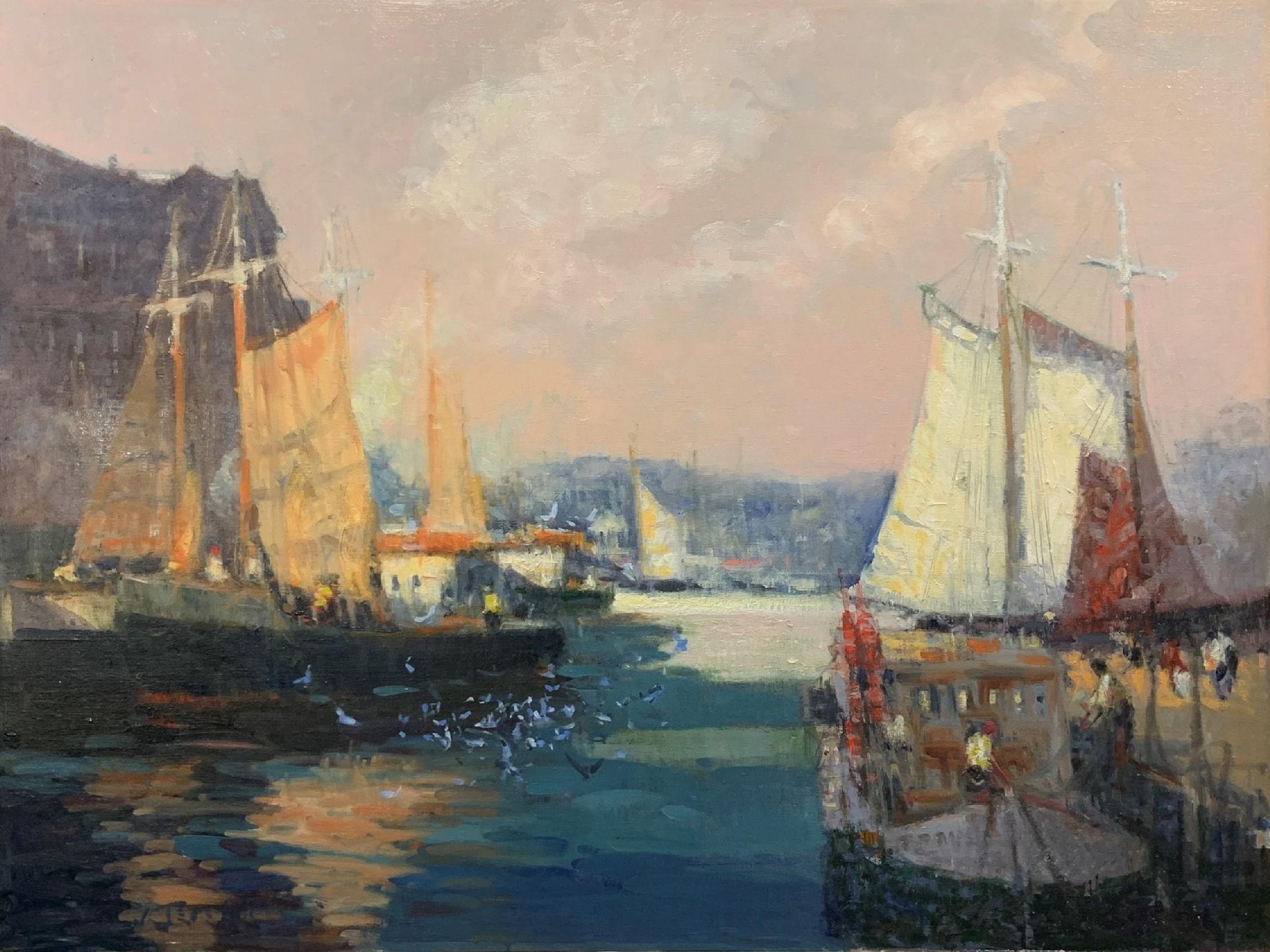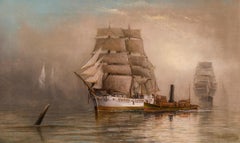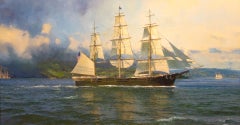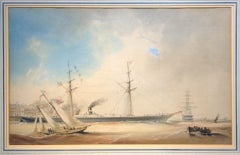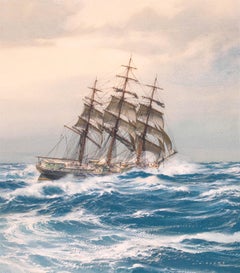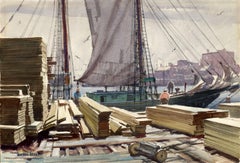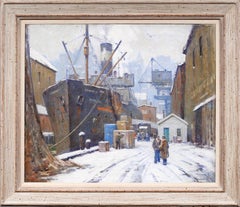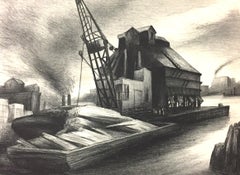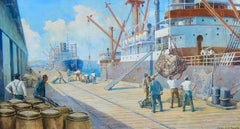Items Similar to Bark HESPER Unloading Lumber at San Diego
Want more images or videos?
Request additional images or videos from the seller
1 of 9
David ThimganBark HESPER Unloading Lumber at San DiegoDated 2002
Dated 2002
$23,000
£17,508.76
€20,016.21
CA$32,361.31
A$35,397.95
CHF 18,637.98
MX$422,615.48
NOK 237,543.81
SEK 217,295.90
DKK 149,500.61
About the Item
This bright and serene scene of ships unloading off San Diego, California features a ship with a less than quiet history. The painting shows a typically bright and sunny Southern California day, the deep blue waters of San Diego providing the perfect backdrop for unloading crucial lumber for construction. The painting has Thimgan's eye for detail including the historic ship he's depicted, surely with a knowledge of her history, and his ability to so perfectly depict California's coastal landscape and surrounding waters.
Some ships of legend get their reputations not for speed or daring rescues, but for the amount of chaos which happens onboard. Sailors, being generally a superstitious lot, could spread a ship's reputation like wildfire. As with the supposedly haunted places on land, the odd instances become larger tales whispered over strong drink in port or at worst, printed in bold newspaper headlines. The best crews don't want to serve aboard such vessels, so only the most hardened men sign on. Tempers flare and conditions deteriorate. Over time a ship gains the nickname of "hell ship" or "blood ship." This was the fate of the Bark HESPER.
HESPER was purpose built in 1882 for the Pacific "Triangle Trade" - carrying lumber to Australia, coal to Hawaii and sugar to California, though she took on other cargoes in her career. The wooden bark of 603 tons was built by the Halls Brothers Shipyard of Port Blakeley, Washington and she was unusually fast and beautiful for ships of her type with a finely carved figurehead which can be seen near the center of the painting.
For the ship's first seven voyages she operated peacefully for the Halls Yard under their partnership with a Captain Cygnus Ryder. When Ryder sold his interest in the ship to the Halls they put HESPER under the command of Captain J.F. Sodergren- a man known for high standards and getting the most out of ship and crew. Sodergren's Second Mate, Mr. Fitzgerald, was particularly known as a brute enforcer of discipline.
A March 1893 headline read, "MUTINY AND MURDER. Bloody Work on Board the Bark Hesper. A DARING PLOT FRUSTRATED." HESPER left NSW, Australia on December 22nd with a load of coal bound for San Francisco. Sodergren had just gotten married and not only was his new wife onboard but among the crew it was whispered that $20,000 was being transported in the ship's strongbox. A plot was hatched to steal both wife and cash.
Three weeks later, on January 13th, five of her crew attempted mutiny- hoping to do away with the Captain, mates and two other loyal crew, they would take control of the ship and sail to China or Chile, sell the cargo and outfit the ship for piracy. 2nd Mate Fitzgerald was ambushed on deck and fell to a galley hatchet but when Fitzgerald didn't call for relief at the end of his watch, the First Mate warned the Captain who went on deck, pistol at the ready. The plot relied upon ambush, so upon sight of the revolver the perpetrators surrendered to arrest. The ship rerouted to Tahiti and the men confessed before the US Consul Doty whereupon they were held until another ship could deliver them to a very public and famous trial in San Francisco and eventually up to the US Supreme Court. Three were convicted and one hanged.
You might think that with the poor treatment of sailors mutinies were common, but actually they were rare. Ship's officers had firearms and crews only knives and belaying pins. If a plot failed it was well known that the punishment for mutiny was hanging. So even though bad pay, short rations and poor treatment were common it often wasn't enough to make it worthwhile.
The publicized trial made HESPER notorious, and the gossip of the wharf took hold. Before long it was the ship itself, now said to be a haunted hell-ship, that was to blame. Later newspaper reports of the ship simply making port were accompanied by newspaper articles about the mutiny. The Halls found it impossible to get crews aboard her and once there to keep them from jumping ship. She was sold and transferred to British registry, but the new owners went bankrupt. The haunted reputation now firmly cemented, HESPER lay at anchor for three years before she was sold for a voyage to Chile with lumber and to seek treasure at Cocos Island. On the way she would end her career with another mutiny and sinking in shallow water off Peru.
Signed LL, Sight Size 15 x 30 inches
- Creator:David Thimgan (1955 - 2003, American)
- Creation Year:Dated 2002
- Dimensions:Height: 21 in (53.34 cm)Width: 36 in (91.44 cm)
- Medium:
- Movement & Style:
- Period:
- Condition:
- Gallery Location:Costa Mesa, CA
- Reference Number:1stDibs: LU2139211947612
About the Seller
No Reviews Yet
Vetted Professional Seller
Every seller passes strict standards for authenticity and reliability
Established in 1972
1stDibs seller since 2022
6 sales on 1stDibs
- ShippingRetrieving quote...Shipping from: Costa Mesa, CA
- Return Policy
More From This Seller
View AllComing Through the Mists, Maine Harbor
By George M. Hathaway
Located in Costa Mesa, CA
In this atmospheric Maine harbor view, the grey tone of the fog enveloping the sea and sky lend an air of realism to a striking composition. Granite and green are the colors of the Maine Coast...
Category
1890s Other Art Style Paintings
Materials
Canvas, Oil
The Clipper FLYING FISH in San Francisco Bay
Located in Costa Mesa, CA
One of the most exciting races between American clipper ships took place between October, 1852 and January, 1853. The vessels involved were the crack clippers FLYING FISH, JOHN GILPIN and WILD PIGEON. Departing New York, each a few days apart, the three ships met up off Cape Horn and proceeded, often in sight of one another, to fly up the west coast to San Francisco.
The JOHN GILPIN gambled by heading farther west into the pacific where a strong northerly got her to San Francisco first. FLYING FISH and WILD PIGEON remained in sight of one another for most of the voyage in their dash up the coast. FLYING FISH arrived a day after GILPIN, but having left New York three days behind her adversary, was declared the winner.
This view shows an excellent starboard view of the great FLYING FISH on her entry into San Francisco Bay. The water has superb light and reflection while the Marin headlands show as her backdrop, with the ever-present misty atmosphere of this important California port. A well captured moment of one of the fastest and most powerful 19th century great sailing ships created.
Sight Size: 18 x 34 inches
Vallejo Gallery...
Category
1990s Paintings
Materials
Canvas, Oil
Shipping in the River Humber Off Hull, England
Located in Costa Mesa, CA
This original watercolor on paper features traffic on the River Humber in the City of Hull. Hull or Kingston upon Hull, is a port city in East Yorkshire, England. The painting is hig...
Category
1870s Victorian Landscape Paintings
Materials
Paper, Watercolor
Ship GLORY OF THE SEAS
Located in Costa Mesa, CA
Carl G. Evers was an artist with a very impressive body of work who deserves more attention in the maritime genre. The son of a maritime engineer father and an artist mother, it seem...
Category
Mid-20th Century Realist Paintings
Materials
Paper, Watercolor
The Maryland Ship DEFENCE Chases the British Sloop OTTER Down Chesapeake Bay
By Leslie Arthur Wilcox
Located in Costa Mesa, CA
This large and exciting scene features an American Revolutionary War battle in Chesapeake Bay. With great color and lively brushwork this painting was done at a large scale which captures a grand vista of the Bay along with many small vignettes to draw the eye. No less than ten other ships surround the two combatant vessels as they exchange cannon fire...
Category
1970s Paintings
Materials
Canvas, Oil
William Astor's Schooner AMBASSADRESS Leads the Regatta
By James Edward Buttersworth
Located in Costa Mesa, CA
William Astor Pilots the New York Yacht Club Run
A superior and graceful schooner as grand as any ever built, AMBASSADRESS was William Backhouse Astor, Jr's "floating home" from its launch in 1877 until he sold it in 1884 and purchased his massive steam/sail yacht...
Category
1870s American Realist Paintings
Materials
Canvas, Oil
You May Also Like
The Lumber Wharf
By Gordon Grant
Located in New York, NY
Gordon Hope Grant (1875-1962) created the watercolor entitled “The Lumber Wharf” in circa 1947. It is signed in the lower left 1 inch above the paper edge. The watercolor paper size ...
Category
1940s Naturalistic Landscape Drawings and Watercolors
Materials
Watercolor
"Unloading the Freight" Antique American Impressionist Exhibited Dock Scene
Located in Buffalo, NY
Important and exhibited American impressionist dock scene by Junius Allen (1898 - 1962). Oil on canvas. Framed. Signed. Image size, measuring 25 by 30 inches.
Category
1940s Impressionist Landscape Paintings
Materials
Canvas, Oil
$6,200 Sale Price
20% Off
Ann Nooney, (Loading the Lumber Barge, NYC)
By Ann Nooney
Located in New York, NY
The dimensions are for the image. There are large margins. Signed in pencil.
A native New Yorker, Ann Nooney (1900-1970), recorded the urban scene while on the Works Progress Admini...
Category
1930s American Realist Landscape Prints
Materials
Lithograph
Dock Workers Unloading Freighter
By Anton Otto Fischer
Located in Fort Washington, PA
Medium: Oil on Canvas
Signature: Signed Lower Right
Category
20th Century Figurative Paintings
Materials
Canvas, Oil
Tugboat Up for Repairs
By John Terelak
Located in Greenwich, CT
John Terelak Biography
American, b. 1942
John Charles Terelak is recognized as one of America's finest living impressionists. Born in Boston, Massachusetts, he received formal art i...
Category
2010s American Impressionist Landscape Paintings
Materials
Canvas, Oil
Unloading the Catch
By John Terelak
Located in Greenwich, CT
John Terelak Biography
American, b. 1942
John Charles Terelak is recognized as one of America's finest living impressionists. Born in Boston, Massachusetts, he received formal art i...
Category
2010s Landscape Paintings
Materials
Canvas, Oil
More Ways To Browse
Oil Paintings Art Drinking Scenes
Bark Art
Bark Painting
J Manning
Carved Figurehead
Framed Landscape Countryside Oil Painting
Abstract Flower
Set Of 4 Framed Art
Two Oil Paintings On Board
Sold Paintings
Large Original Pop Art Paintings
Painting Of Rivers And Trees
Still Life Flowers In A Vase Paintings
Coastal Paintings
Antique Painting With Frame
Blue And White Still Life Painting
Diptych Art
Impressionist In Frame
